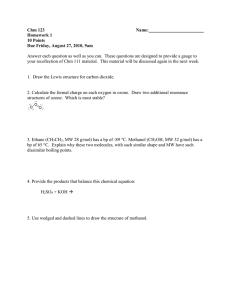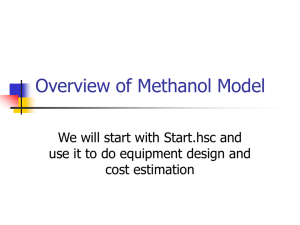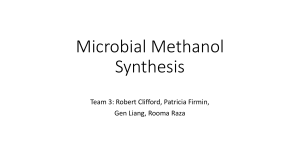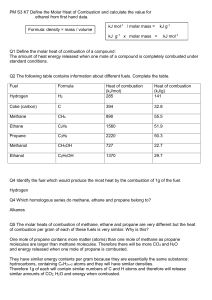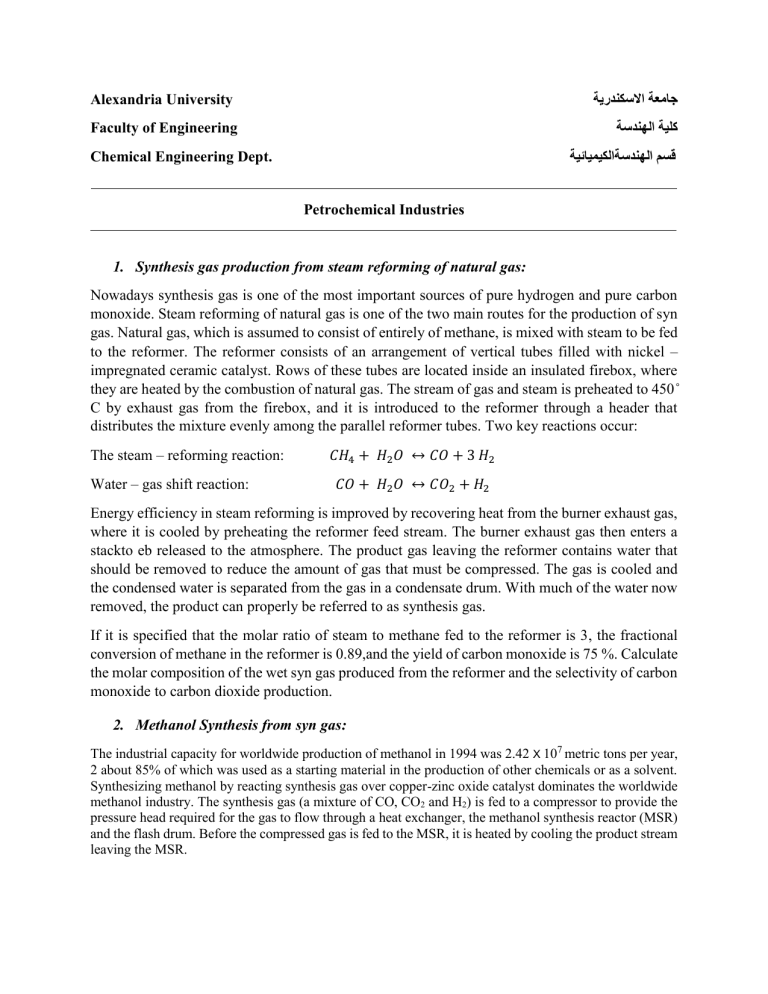
جامعة االسكندرية Alexandria University كلية الهندسة Faculty of Engineering قسم الهندسةالكيميائية Chemical Engineering Dept. Petrochemical Industries 1. Synthesis gas production from steam reforming of natural gas: Nowadays synthesis gas is one of the most important sources of pure hydrogen and pure carbon monoxide. Steam reforming of natural gas is one of the two main routes for the production of syn gas. Natural gas, which is assumed to consist of entirely of methane, is mixed with steam to be fed to the reformer. The reformer consists of an arrangement of vertical tubes filled with nickel – impregnated ceramic catalyst. Rows of these tubes are located inside an insulated firebox, where they are heated by the combustion of natural gas. The stream of gas and steam is preheated to 450 ̊ C by exhaust gas from the firebox, and it is introduced to the reformer through a header that distributes the mixture evenly among the parallel reformer tubes. Two key reactions occur: The steam – reforming reaction: Water – gas shift reaction: 𝐶𝐻4 + 𝐻2 𝑂 ↔ 𝐶𝑂 + 3 𝐻2 𝐶𝑂 + 𝐻2 𝑂 ↔ 𝐶𝑂2 + 𝐻2 Energy efficiency in steam reforming is improved by recovering heat from the burner exhaust gas, where it is cooled by preheating the reformer feed stream. The burner exhaust gas then enters a stackto eb released to the atmosphere. The product gas leaving the reformer contains water that should be removed to reduce the amount of gas that must be compressed. The gas is cooled and the condensed water is separated from the gas in a condensate drum. With much of the water now removed, the product can properly be referred to as synthesis gas. If it is specified that the molar ratio of steam to methane fed to the reformer is 3, the fractional conversion of methane in the reformer is 0.89,and the yield of carbon monoxide is 75 %. Calculate the molar composition of the wet syn gas produced from the reformer and the selectivity of carbon monoxide to carbon dioxide production. 2. Methanol Synthesis from syn gas: The industrial capacity for worldwide production of methanol in 1994 was 2.42 X 107 metric tons per year, 2 about 85% of which was used as a starting material in the production of other chemicals or as a solvent. Synthesizing methanol by reacting synthesis gas over copper-zinc oxide catalyst dominates the worldwide methanol industry. The synthesis gas (a mixture of CO, CO2 and H2) is fed to a compressor to provide the pressure head required for the gas to flow through a heat exchanger, the methanol synthesis reactor (MSR) and the flash drum. Before the compressed gas is fed to the MSR, it is heated by cooling the product stream leaving the MSR. The key reactions occurring in the MSR are: 𝐶𝑂 + 2𝐻2 → 𝐶𝐻3 𝑂𝐻 𝐶𝑂2 + 3𝐻2 → 𝐶𝐻3 𝑂𝐻 + 𝐻2 𝑂 The product gas leaving the MSR is cooled then fed to the flash drum where a liquid consisting of condensed methanol and dissolved gases is separated, where the methanol is sent to a methanol purification unit. The uncondensed gases are split, with a portion being purged from the system and the remainder forming the recycle gas that is blended with fresh synthesis gas to form the feed to the compressor. Knowing that the single pass conversion of carbon monoxide in the MSR is 70% and the methanol yield is 63.3%. Calculate the molar composition of the product stream, where the feed to the MSR contains 25% C, 5% inert CH4, and the balance H2. 3. Formaldehyde Synthesis from catalyzed oxidation of methanol: Formaldehyde solutions are produced by the catalyzed oxidation of methanol. In the UIF process, the reaction occurs on the surface of silver-crystal catalyst at temperatures 620-680 ̊ C, where the methanol is dehydrated and partially oxidized: 𝐶𝐻3 𝑂𝐻 → 𝐶𝐻2 𝑂 + 𝐻2 𝐶𝐻3 𝑂𝐻 + 1 𝑂 → 𝐶𝐻2 𝑂 + 𝐻2 𝑂 2 2 The methanol – water mixture is continuously fed by pump to the methanol evaporator. The required process air is filtered then passed through a blower to the methanol evaporator. The methanol/water/air mixture then enters the catalytic reactor where the conversion of methanol to formaldehyde occurs. The reaction gases emerging from the catalysis contain formaldehyde, water, nitrogen, hydrogen as well as non-converted methanol. They are cooled to 150 ̊ C, in a waste heat boiler, where the amount of heat released is sufficient for generating steam up to 40 bar pressure required for heating the methanol evaporator. The methanol is then separated from the formaldehyde and hydrogen in a multiple unit process. A 60 % single pass conversion of methanol is achieved in the reactor, the concentration of the methanol solution fed to the process is 60 % by weight, and the production rate of formaldehyde is 900 kg/h. Calculate the required feed rate of methanol solution to the process (kg/h). 4. Propylene production from the Catalytic Dehydrogenation of propane: The catalytic dehydrogenation of propane is carried out in a continuous packed-bed reactor. One thousand kilograms per hour of pure propane is preheated to a temperature of 670 ̊ C before it passes into the reactor. The reactor effluent gas, which includes propane, propylene, methane and hydrogen, is cooled from 800 ̊C to 110 ̊ C and fed to an absorption tower, where the propane and propylene are dissolved in oil. The oil then goes to a stripping tower in which it is heated, releasing the dissolved gases; these gases are recompressed and sent to a distillation tower in which the propane and propylene are separated. The propane stream is recycled back to join the feed to the reactor preheater. The product stream from the distillation column contains 98% propylene and recycle stream is 97% propane. The stripped oil is recycled to the absorption tower. If the overall conversion of propane is 98.2%, calculate the propylene productivity in (kg/h) If the ratio of the product stream from the distillation tower to the recycle stream is 2:1, calculate the single pass conversion of propane in the catalytic reactor 5. Methyl Chloride production from methane chlorination: Methane reacts with chlorine to produce methyl chloride and hydrogen chloride. Once formed, the methyl chloride may undergo further chlorination to form methylene chloride (CH2Cl2), chloroform, and carbon tetrachloride. A methyl chloride production process consists of a reactor, a condenser, a distillation column, and an absorption column. A gas stream containing 80.0 mole% methane and the balance chlorine is fed to the reactor. In the reactor a single-pass chlorine conversion of essentially 100% is attained, the mole ratio of methyl chloride to methylene chloride in the product is 5:1, and negligible amounts of chloroform and carbon tetrachloride are formed. The product stream flows to the condenser. Two streams emerge from the condenser: the liquid condensate, which contains essentially all of the methyl chloride and methylene chloride in the reactor effluent, and a gas containing the methane and hydrogen chloride. The condensate goes to the distillation column in which the two component species are separated. The gas leaving the condenser flows to the absorption column where it contacts an aqueous solution. The solution absorbs essentially all of the HCl and none of the CH4 in the feed. The liquid leaving the absorber is pumped elsewhere in the plant for further processing, and the methane is recycled to join the fresh feed to the process (a mixture of methane and chlorine). The combined stream is the feed to the reactor. Calculate the molar flow rates and compositions of the fresh feed and the recycle stream required to achieve a methyl chloride production rate of 1000 kg/h.
